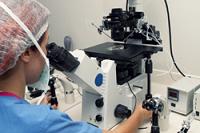Advertisment
ACC 2014 Report: Study compares heart valve systems

Among patients undergoing aortic valve replacement using a catheter tube, a comparison of two types of heart valve technologies, balloon-expandable or self-expandable valve systems, found a greater rate of device success with the balloon-expandable valve, according to a JAMA study released online to coincide with presentation at the 2014 American College of Cardiology Scientific Sessions.
Transcatheter aortic valve replacement (TAVR) has emerged as a new option for patients with severe narrowing of the aortic valve and as an effective alternative treatment method to surgical aortic valve replacement in selected high-risk patients. Different from surgery, transcatheter placement (via the patient’s groin) of aortic valve prostheses requires either a self-expandable or balloon-expandable system. A direct comparison of these 2 systems has not been previously performed, according to background information in the article.
Mohamed Abdel-Wahab, M.D., of the Segeberger Kliniken, Bad Segeberg, Germany, and colleagues with the CHOICE trial, randomly assigned patients with aortic stenosis (narrowing) who met other criteria to receive either a balloon-expandable valve (n = 121) or self-expandable valve (n = 120). Device success was defined by several measures, including successful vascular access and deployment of the device and retrieval of the delivery system, correct position of the device, and performance of the heart valve without moderate or severe regurgitation (backflow of blood through the valve).
The researchers found that device success occurred in 116 of 121 patients (95.9 percent) in the balloon-expandable group and 93 of 120 patients (77.5 percent) of patients in the self-expandable group. This difference was attributed to a lower frequency of more-than-mild aortic regurgitation (4.1 percent vs 18.3 percent) and the less frequent need for implanting more than 1 valve (0.8 percent vs 5.8 percent) in the balloon-expandable valve group.
Bleeding and vascular complications were not significantly different between groups. Cardiovascular mortality at 30 days was 4.1 percent in the balloon-expandable valve group and 4.3 percent in the self-expandable valve group. Need for placement of a new permanent pacemaker was less frequent in the balloon-expandable valve group.
“With an accumulating body of evidence linking more-than-mild aortic regurgitation and consequently device failure with a worse clinical outcome after transcatheter aortic valve replacement, the findings of the CHOICE trial may have important clinical implications. Notably, at short-term follow-up, improvement of heart failure symptoms was more frequently observed with the balloon-expandable valve, whereas minor stroke rates were numerically higher. Nevertheless, long-term follow-up of the CHOICE population should be awaited to determine whether the observed differences in device success will translate into a clinically relevant overall benefit for the balloon-expandable valve,” the authors write.
(doi:10.1001/jama.2014.3316; Available at http://media.jamanetwork.com)
This trial was sponsored by the Heart Center, Segeberger Kliniken GmbH, Bad Segeberg, Germany. Please see the article for additional information, including other authors, author contributions and affiliations, financial disclosures, etc.
Editorial: Selection of Valves for TAVR – Is the CHOICE Clear?
Further investigation is needed to determine which valve examined in this study will provide better long-term survival rate and better quality of life, write E. Murat Tuzcu, M.D., and Samir R. Kapadia, M.D., of the Cleveland Clinic, in an accompanying editorial.
“Continued efforts at understanding the risks and benefits of TAVR particularly in relation to patient characteristics, and long term outcomes are imperative for continued progress and refinement of these revolutionary devices. Additional rigorous randomized trials, like the CHOICE trial, will provide the quality of evidence necessary to ensure optimal use and optimal patient outcomes from TAVR.”
(doi:10.1001/jama.2014.3317; Available pre-embargo to the media at http://media.jamanetwork.com)
Contact: Mohamed Abdel-Wahab, M.D.
mohamed.abdel-wahab@segebergerkliniken.de
The JAMA Network Journals





